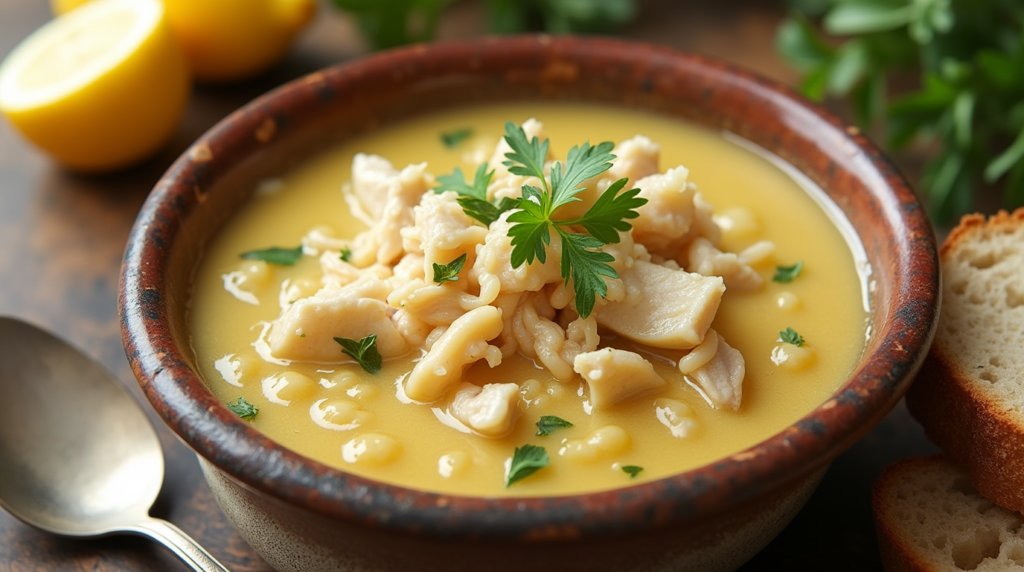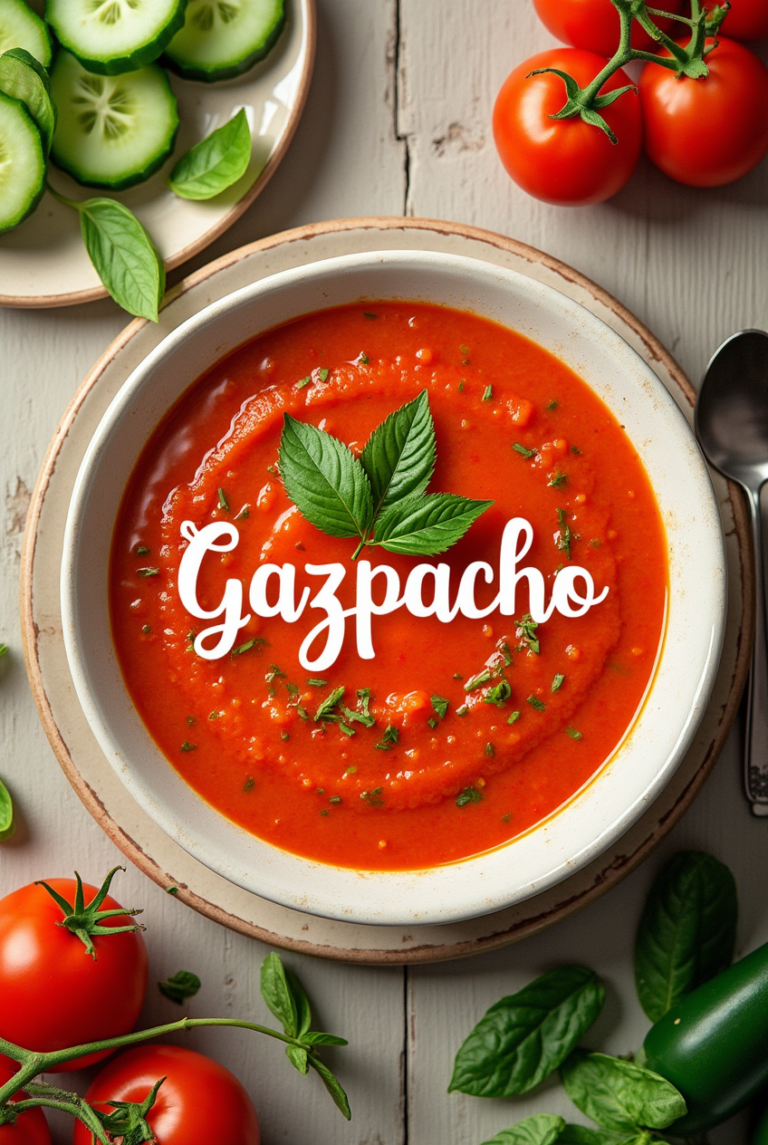Avgolemono Soup: The Irresistible Creamy Greek Classic You Need to Try Now
There’s something comforting and deeply nostalgic about a bowl of soup, especially when it’s a beloved traditional dish like Avgolemono. This velvety, lemony, egg-thickened Greek soup isn’t just food—it’s a warm hug in a bowl. Whether you’ve grown up with a Greek yiayia who made it every Sunday or you’ve never heard of it until today, this dish deserves a spot on your culinary radar. Rich yet light, zesty yet creamy, Avgolemono soup balances contrasts in a way that’s utterly satisfying and unique. Let’s dive into what makes this classic Greek soup so special, how to make it at home, and why it just might become your new go-to comfort food.

Table of Contents
What is Avgolemono Soup?
Avgolemono, literally translating to “egg-lemon,” is one of the crown jewels of Greek cuisine. More than just a dish, it’s a tradition—a staple in Greek households passed down through generations. Typically made with a base of chicken broth, rice or orzo, eggs, and fresh lemon juice, this soup has a velvety texture and a bright, citrusy kick. It’s a testament to how a few humble ingredients can be transformed into something extraordinary.
The origins of Avgolemono date back centuries and are believed to have Middle Eastern roots, particularly from Sephardic Jewish communities, before becoming deeply integrated into Greek culinary traditions. It’s not just soup; it’s often used as a sauce over meats and vegetables in Greece, showing its versatility. However, in soup form, it has earned its iconic status.
Avgolemono is more than just food—it’s often part of holiday meals, healing rituals when someone is sick, and special occasions like Easter. It carries emotional weight for many, evoking memories of family gatherings and cozy kitchens. In Greek culture, the preparation of this soup isn’t rushed. It’s a deliberate process, reflecting care and affection.
What sets Avgolemono apart from other soups is the emulsion of eggs and lemon juice slowly added to hot broth. This technique thickens the soup without cream or flour, creating a silky texture that feels luxurious yet wholesome. It’s a perfect example of how technique meets tradition in Greek cooking.
The Key Ingredients That Make Avgolemono Unique
The magic of Avgolemono lies in its simplicity and balance. Each ingredient plays a crucial role in building flavor and texture. Let’s break down the core elements that define this iconic soup:
Chicken Broth: The Base of Flavor
A good Avgolemono starts with a rich, homemade chicken broth. This isn’t the place to cut corners. Simmering a whole chicken with aromatics like onion, garlic, celery, and bay leaves results in a deeply flavorful stock that forms the foundation of the soup. The chicken also serves as the main protein once shredded and added back into the soup, making it a one-pot meal full of substance.
The quality of the broth can make or break the final dish. It should be golden, savory, and infused with enough body to hold up to the lemon and egg mixture. Store-bought broth can work in a pinch, but nothing compares to the homemade version.
Eggs and Lemon: The Creamy Tang
This is where Avgolemono gets its name—and its signature flavor. The eggs, when whisked with lemon juice and tempered with hot broth, create a smooth, creamy emulsion that thickens the soup naturally. It’s a delicate process that requires care to avoid curdling the eggs, but the result is worth it: a creamy consistency without any dairy or added thickeners.
The lemon isn’t just a flavor enhancer—it’s the soul of the dish. It cuts through the richness of the chicken and eggs, providing a bright contrast that elevates the entire experience. Freshly squeezed lemon juice is non-negotiable here. Bottled just won’t do.
Rice or Orzo: Texture and Heartiness
Most traditional recipes call for either white rice or orzo pasta to give the soup its body. Rice offers a more rustic, filling option, while orzo brings a slightly silkier texture. Either choice works beautifully and turns this into a satisfying meal that stands on its own.
Some modern recipes may use other grains like quinoa or even couscous, but for that authentic Greek experience, stick with rice or orzo. It soaks up the flavors of the broth and provides the perfect balance to the creamy lemon-egg mixture.
These three core ingredients—when prepared and combined properly—create a bowl of soup that is comforting, flavorful, and uniquely Greek. Whether you’re sipping it as a starter or diving into a big bowl for dinner, Avgolemono is all about balance, warmth, and tradition.
How to Make Traditional Avgolemono Soup
Making Avgolemono soup at home is a rewarding experience. While it might seem intimidating at first, especially the egg-lemon tempering part, once you understand the steps, it becomes a comforting and fairly easy recipe to whip up.

Step-by-Step Preparation
- Prepare the Chicken Broth
Begin by simmering a whole chicken or bone-in chicken thighs with water, onions, celery, carrots, garlic, and bay leaves. Simmer for about an hour to extract all the flavor and then strain the broth. Shred the chicken and set it aside. - Cook the Rice or Orzo
In the strained broth, add your choice of rice or orzo. Let it cook until tender. This will be the base of the soup. - Make the Avgolemono (Egg-Lemon) Mixture
In a separate bowl, whisk together eggs and freshly squeezed lemon juice. Here comes the critical part—tempering. Slowly add a ladle of hot broth into the egg mixture while whisking constantly. Do this a couple of times until the egg mixture is warm. - Combine Carefully
Slowly pour the tempered egg-lemon mixture back into the pot, stirring gently. This will thicken the soup and create that luscious texture without scrambling the eggs. - Add Chicken and Season
Stir in the shredded chicken. Season with salt and freshly ground black pepper. Let the soup sit for a few minutes to thicken further, but avoid boiling it after adding the egg mixture.
Pro Tips for Success
- Always temper the egg mixture properly to avoid curdling.
- Use freshly squeezed lemon juice for the brightest flavor.
- Simmer, don’t boil, after adding the eggs.
- Make it ahead—it tastes even better the next day.
This method results in a traditional Avgolemono soup that’s comforting, filling, and packed with flavor. Once you’ve mastered it, you’ll find it’s a recipe worth repeating.
Variations of Avgolemono Soup Across Greece
While the traditional version is universally loved, Greek cuisine is rich in regional diversity. Different parts of Greece—and even different families—have their own spin on Avgolemono soup, which adds to its charm.
Regional Twists
In Northern Greece, for example, it’s common to add more lemon for an extra tangy punch. Meanwhile, in the islands, herbs like dill or parsley may be incorporated to brighten up the flavor. Some regions prefer a thinner broth, while others like it thicker and creamier.
Vegetarian or Vegan Versions
Though the classic version is meat-based, Avgolemono can easily be adapted for vegetarians or vegans. Vegetable broth replaces chicken stock, and chickpeas or lentils can stand in for meat. For the egg substitute, some use blended tofu or plant-based cream with lemon to mimic the texture.
Modern Adaptations
Contemporary chefs are putting creative spins on Avgolemono. Some add saffron or turmeric for color and complexity. Others experiment with different grains like farro or barley. And in modern Greek restaurants, you might even find a deconstructed version served with foam or infused oils.
These variations keep Avgolemono alive in both tradition and innovation, allowing each cook to make it their own while preserving its heart.
The Nutritional Value of Avgolemono Soup
Avgolemono soup isn’t just delicious—it’s also surprisingly nutritious. This dish blends protein, healthy fats, and carbohydrates in one bowl, making it a balanced meal that’s as wholesome as it is flavorful. Whether you’re watching your diet or simply looking for a comfort food that won’t derail your health goals, Avgolemono checks all the boxes.
Health Benefits of Key Ingredients
Let’s start with the chicken. Lean, skinless chicken is a powerhouse of protein, essential for muscle repair, immune function, and satiety. It’s low in fat but high in nutrients like B vitamins, selenium, and phosphorus. The homemade broth, simmered with bones and connective tissue, also offers a natural source of collagen and gelatin—great for joint health and gut function.
Then there are the eggs. These little nutrition bombs provide high-quality protein, healthy fats, and important micronutrients like choline (great for brain health), vitamin D, and selenium. Many people shy away from eggs due to cholesterol concerns, but recent research has shown that dietary cholesterol doesn’t significantly impact blood cholesterol for most people.
Lemon juice isn’t just there for flavor. It’s rich in vitamin C, a powerful antioxidant that supports immune health and improves iron absorption. It also gives the soup its refreshing brightness and helps balance the richness of the eggs and chicken.
Carbohydrates in the form of rice or orzo offer energy and fiber. Choosing whole grain orzo or brown rice can even increase the fiber content, making the soup more satisfying and stabilizing blood sugar levels.
Macronutrient Breakdown (Per One-Bowl Serving)
| Nutrient | Approximate Amount |
|---|---|
| Calories | 250–350 kcal |
| Protein | 20–25 g |
| Carbohydrates | 20–30 g |
| Fat | 10–15 g |
| Fiber | 1–3 g |
| Vitamin C | 10–20% DV |
| Vitamin B6 | 20–30% DV |
*DV = Daily Value
Ideal for Special Diets?
One of the beauties of Avgolemono is how adaptable it is to various dietary needs. It’s naturally gluten-free if made with rice. It’s low in sugar, relatively low in calories, and rich in whole-food ingredients. Plus, it’s a great option for those following Mediterranean or anti-inflammatory diets, which emphasize lean protein, good fats, and fresh produce.
For those watching their fat intake, it’s easy to make a lighter version by reducing the egg yolks or using egg whites. Want a dairy-free creamy soup? You’re already there—no dairy is used, yet it still delivers that rich, creamy texture thanks to the egg-lemon emulsion.
In essence, Avgolemono isn’t just a comfort food—it’s a healthful, healing, and deeply satisfying meal that fits well into a balanced diet.
Avgolemono Soup and Its Role in Greek Culture
To understand Avgolemono soup fully, we need to look beyond the ingredients and the recipe. This dish holds a cherished place in Greek culture, where food is deeply interwoven with family, history, and identity. Avgolemono is more than just sustenance—it’s a symbol of care, comfort, and continuity.
A Soup for All Seasons and Occasions
In Greek households, Avgolemono is often associated with major life moments—both celebratory and solemn. It’s served during Easter as part of the traditional meal after the midnight church service. It’s also the go-to remedy for colds and flu, lovingly offered by parents and grandparents as a healing elixir.
But its significance goes even deeper. The soup represents togetherness. Its preparation is often a family affair, from simmering the chicken to whisking the egg-lemon mixture. It’s not uncommon for Greek children to grow up learning how to temper eggs properly, a rite of passage into culinary adulthood.
A Legacy Passed Down Generations
Many Greeks share stories of their mothers or grandmothers teaching them how to make Avgolemono, each with her own secret touch. Maybe it’s an extra splash of lemon, a dash of oregano, or the way the egg is whisked just so. These small differences are like fingerprints—unique to each family and imbued with love and tradition.
Food in Greek culture is about sharing, and Avgolemono is one of those dishes that always shows up when someone needs a little extra care. Whether someone is sick, tired, celebrating, or grieving, a bowl of Avgolemono always seems like the right answer.
Cultural Significance in Greek Cuisine
While many cuisines boast a chicken soup variation, Avgolemono is uniquely Greek. Its use of lemon and eggs as thickening agents sets it apart from the classic chicken noodle or matzo ball soups found elsewhere. It speaks to the Greek palate—bold, tangy, and full of life.
In tavernas and family kitchens alike, this soup holds a place of honor. It’s often listed on menus as a first course but is hearty enough to serve as a main. It’s both rustic and refined, humble yet luxurious.
In the end, Avgolemono isn’t just food. It’s a piece of cultural heritage—a warm bowl of Greek history that’s passed from generation to generation with every ladle.
Common Mistakes to Avoid When Making Avgolemono Soup
As magical as Avgolemono can be, it’s also delicate. One small misstep can turn your creamy soup into a curdled mess. But don’t worry—we’ve got you covered with a guide to common pitfalls and how to dodge them.
Mistake 1: Scrambling the Eggs
This is by far the most common issue, and it happens when the hot broth is added to the eggs too quickly or without constant whisking. The key to avoiding this is tempering. Slowly and gradually incorporate hot broth into the egg-lemon mixture while whisking continuously. Patience here pays off—don’t rush this step.
Mistake 2: Boiling After Adding Eggs
Even if you’ve tempered perfectly, turning the heat back up after adding the eggs can ruin the emulsion. Once the eggs are in, keep the soup on low heat or remove it entirely from the stove. A gentle stir will suffice as it finishes thickening.
Mistake 3: Using Bottled Lemon Juice
Fresh lemon juice isn’t optional. Bottled juice lacks the brightness and complexity of fresh citrus. Since lemon is a starring ingredient, it deserves the best.
Mistake 4: Skimping on the Broth Quality
If you start with bland broth, you’ll end with bland soup. Always use homemade chicken broth if possible. If using store-bought, choose a high-quality, low-sodium version and consider simmering it with extra aromatics for more depth.
Mistake 5: Overcooking the Rice or Orzo
It’s easy to let the rice or pasta overcook while preparing the other components. Keep an eye on it and aim for just tender—otherwise, it’ll turn mushy, especially when reheated.
Mistake 6: Not Seasoning Properly
Salt and pepper are crucial to balance the flavors. Taste your soup before serving and adjust accordingly. Sometimes a touch more lemon or a sprinkle of fresh herbs like dill or parsley can really elevate the flavor.
Avoid these pitfalls and you’ll be well on your way to mastering this beloved Greek comfort food like a seasoned home cook.
Tips for Making Avgolemono Soup in Advance
Avgolemono is best served fresh, but that doesn’t mean you can’t make it ahead of time. Whether you’re prepping for a busy week, feeding a crowd, or just love having comforting meals on standby, there are a few tips to help you enjoy the soup at its best—even a day or two later.
Make the Base First
One of the smartest tricks for prepping Avgolemono in advance is to make everything except the egg-lemon mixture. That means cooking your broth, rice or orzo, and even shredding your chicken. Store this “soup base” in an airtight container in the fridge for up to 3 days.
When you’re ready to eat, gently reheat the base on the stove. Once it’s hot, prepare your fresh egg-lemon mixture and temper it with the reheated broth. This way, you avoid the risk of curdling that often happens when reheating the entire finished soup.
Storing and Reheating Leftovers
If you’ve already combined everything, you can still store leftovers, but you’ll need to be a bit more careful. Transfer the soup to an airtight container and refrigerate. When reheating, use a very low flame and stir constantly—do not let it boil. It’s also helpful to reheat it in a double boiler if you have one.
If the texture changes slightly after refrigeration, don’t worry. A splash of warm broth or water and a gentle whisk can often restore its silky consistency.
Freezing Avgolemono Soup: Yay or Nay?
Here’s where it gets tricky. Because of the eggs, Avgolemono doesn’t freeze very well. The texture often breaks and becomes grainy when thawed. However, you can freeze the soup base (without eggs and lemon) for up to 2 months. When you’re ready to serve, just thaw the base and then add a fresh egg-lemon emulsion for best results.
Meal Prep Bonus
If you love meal prepping, consider storing the lemon juice and whisked eggs in separate containers in your fridge and portioning out your broth and rice/chicken mixture in jars. When it’s time to eat, combine them fresh. It’s a bit of extra work, but totally worth it for creamy, dreamy soup on demand.
Pairing Ideas: What to Serve with Avgolemono Soup
Avgolemono is a satisfying dish on its own, but pairing it with the right sides or drinks can turn a simple bowl into a full Greek-inspired meal. Whether you’re planning a cozy dinner or a festive spread, here are some delicious ideas to complement your soup.
Classic Greek Bread and Pita
A slice of crusty bread or warm pita is the perfect sidekick. Use it to soak up every last drop of the soup. Go for fresh Greek-style bread with a crispy crust and airy center, or even garlic pita for an extra punch.
Greek Salads and Veggies
Balance the warmth of the soup with a cool, crisp salad. A classic Greek salad with tomatoes, cucumber, red onion, kalamata olives, and feta drizzled in olive oil is a natural match. Want something lighter? Try a simple cucumber-dill yogurt salad.
Roasted vegetables also pair beautifully. Think roasted zucchini, eggplant, or bell peppers tossed in herbs and olive oil. Their rich, smoky flavors contrast perfectly with the bright soup.
Stuffed Grape Leaves (Dolmades)
These vine-wrapped rice parcels add texture and variety to your meal. Some versions include meat, while others are vegetarian with a lemony-herb rice filling. Serve them warm or cold on the side for an authentic Greek feast.
Cheese and Olive Platters
A small plate of assorted Greek cheeses like feta, kasseri, and graviera, along with olives and maybe some sun-dried tomatoes, can turn your Avgolemono meal into a mezze moment. Add a drizzle of olive oil and sprinkle of oregano for that Mediterranean magic.
Beverages That Complement
For drinks, go traditional with a glass of ouzo or retsina if you’re feeling adventurous. Otherwise, a crisp white wine like Assyrtiko or Sauvignon Blanc works wonderfully. Prefer something non-alcoholic? A glass of iced water with a lemon slice or even a cucumber-mint spritz fits the vibe.
Avgolemono for Every Season
While often associated with colder months, Avgolemono’s brightness and balance make it surprisingly adaptable for year-round enjoyment. Here’s how to tweak it for every season without losing its traditional essence.
Winter Comfort Food
There’s nothing better than curling up with a bowl of Avgolemono during the colder months. Use hearty chicken stock and maybe even add a touch more rice or orzo for an extra-filling meal. Serve it alongside roasted winter vegetables or crusty bread.
Add herbs like thyme or rosemary for a slightly earthier taste, and don’t forget the cracked black pepper for a bit of warmth.
Spring Freshness
Spring is lemon’s time to shine, making Avgolemono an ideal seasonal choice. Use fresh spring herbs like dill or mint to brighten the flavor. Pair it with a green salad filled with baby spinach, arugula, and spring onions.
You can even swap the rice for quinoa or farro to give it a modern, nutty twist that still feels light and vibrant.
Summer Lightness
Think it’s too hot for soup in summer? Think again. Serve Avgolemono slightly cooled or lukewarm for a refreshing meal. Use chicken breast instead of darker cuts to keep it lean, and go light on the grains.
Pair with chilled white wine or sparkling water with a splash of lemon. A side of grilled seafood or a Greek-style veggie platter makes it feel like a beachside meal in the Mediterranean.
Fall Warmth
As the leaves change, bring a touch of autumn into your bowl. Add a bit more rice, use bone-in chicken for richness, and throw in some roasted garlic for depth. Serve with a side of warm roasted root vegetables or a fig and walnut salad.
No matter the season, Avgolemono’s flexibility means you can adapt it to your tastes and cravings without losing what makes it special.
Avgolemono Soup for Special Occasions
In Greece, food is never just food—it’s a celebration, a memory, and a gathering of hearts. Avgolemono soup plays a quiet but essential role in Greek festive traditions and special occasions. It’s that familiar taste that marks the holidays, the dish that’s gently ladled into bowls at midnight, or lovingly served after a long day. It’s a dish with emotional depth, and here’s how it shows up at the heart of cherished moments.
A Star at Easter
Perhaps the most iconic moment for Avgolemono is during Greek Easter. After a long day of fasting and a solemn midnight church service, families return home to a warm bowl of this comforting soup. It’s often the first thing eaten to break the fast, symbolizing new life and rebirth—fitting, given Easter’s deep spiritual meaning.
The version served at Easter is sometimes a bit more indulgent, using lamb broth instead of chicken and sometimes including liver or other traditional cuts. The result is a richer, deeper version of the classic.
Comfort Food for Healing
Beyond the holidays, Avgolemono often shows up during times of recovery—after an illness, surgery, or any moment when comfort is needed. Like chicken noodle soup in other cultures, Greeks turn to Avgolemono when they’re feeling under the weather. The combination of easy-to-digest protein, gentle citrus, and soothing warmth makes it ideal for sick days and tender moments.
A Dish of Hospitality
Greek hospitality—filoxenia—is legendary, and Avgolemono often plays a role in it. Whether welcoming guests or sharing a meal with neighbors, this soup offers warmth and care. It’s not flashy or extravagant, but it’s made with love and tradition, and that always shines through.
From Easter feasts to healing meals, Avgolemono is woven into the emotional fabric of Greek life. It’s not just eaten—it’s remembered, shared, and passed on.
How to Customize Avgolemono Soup for Your Tastes
If there’s one thing that makes Avgolemono a staple in many kitchens, it’s how customizable it is. Whether you’re feeding picky eaters, accommodating dietary restrictions, or just craving something a bit different, this soup is flexible enough to make your own.
Spice It Up
Traditional Avgolemono is mild and lemony, but that doesn’t mean you can’t add a little flair. Try a pinch of red pepper flakes, a swirl of harissa, or even some crushed garlic for more depth. Want a Mediterranean kick? Add chopped Kalamata olives or a touch of feta cheese for a salty contrast.
Switch Up the Protein
Chicken is the classic choice, but why not experiment? Turkey works well and is great for using up leftovers. Seafood lovers can try shrimp or white fish for a coastal twist. If you’re vegetarian, substitute chickpeas, lentils, or white beans. They offer a hearty texture and soak up the flavor beautifully.
Make It Heartier or Lighter
Need something more filling? Add more rice or orzo, or stir in sautéed mushrooms, spinach, or kale. Craving something lighter? Use more broth and less starch. You can even skip the grains entirely and enjoy a brothier, almost consommé-like version.
Fresh Herbs and Toppings
Top your soup with fresh dill, parsley, or mint for a vibrant burst of flavor. A swirl of olive oil, cracked pepper, or a sprinkle of lemon zest takes the presentation and flavor up a notch. Croutons or toasted pine nuts can also add a satisfying crunch.
The beauty of Avgolemono is that once you master the basic technique, the possibilities are endless. Every variation feels like a personal version of the original—a dish that’s as adaptable as it is nostalgic.
Essential Tools for Avgolemono Soup
- Stockpot or Dutch Oven – Ideal for simmering chicken and broth evenly.
- Whisk – Key for blending eggs and lemon smoothly.
- Ladle – Helps with precise broth tempering and serving.
- Strainer – Ensures a smooth, clear broth.
- Mixing Bowl – Used for egg-lemon tempering.
- Sharp Knife & Cutting Board – For prepping chicken and lemons.
- Citrus Juicer – Extracts fresh lemon juice without seeds.
- Thermometer (Optional) – Prevents curdling by monitoring broth heat.
- Storage Containers – Great for leftovers or prepping ahead.
- Immersion Blender (Optional) – For modern, blended versions.
Conclusion
Avgolemono soup is more than just a dish—it’s an experience, a story, and a piece of Greek heritage that continues to nourish both body and soul. It’s simple yet elegant, humble yet profound. From its roots in ancient kitchens to its place on modern dinner tables, this creamy, lemony treasure is a testament to the power of tradition, love, and really good food.
Whether you’re sipping it after midnight on Easter, serving it to someone you love, or simply looking for a bowl of comfort, Avgolemono delivers. It invites you to slow down, savor the moment, and appreciate the beauty in simplicity.
So next time you’re looking for a cozy meal with a burst of bright flavor and a touch of soul, you know what to make—Avgolemono soup.
FAQs
1. Can I make Avgolemono soup without eggs?
Yes, you can make a vegan or egg-free version using alternatives like silken tofu, cornstarch, or plant-based creams to mimic the texture. While it won’t taste exactly the same, you’ll still get a creamy and tangy broth.
2. Why did my Avgolemono soup curdle?
The most common reason is adding hot broth to the eggs too quickly or reheating the soup too aggressively. Always temper the eggs slowly and avoid boiling once the eggs are added.
3. Can I freeze Avgolemono soup?
It’s not ideal to freeze the full soup due to the eggs, which can separate when thawed. However, you can freeze the soup base (without the egg-lemon mixture) and add the eggs and lemon fresh after reheating.
4. What kind of rice works best in Avgolemono?
Short-grain white rice or Arborio rice are popular for their starchy, creamy consistency. You can also use orzo for a slightly silkier texture.
5. Is Avgolemono considered a main course or an appetizer?
It can be both! In Greece, it’s often served as a starter, but when made with extra chicken and rice, it easily becomes a hearty main course.







